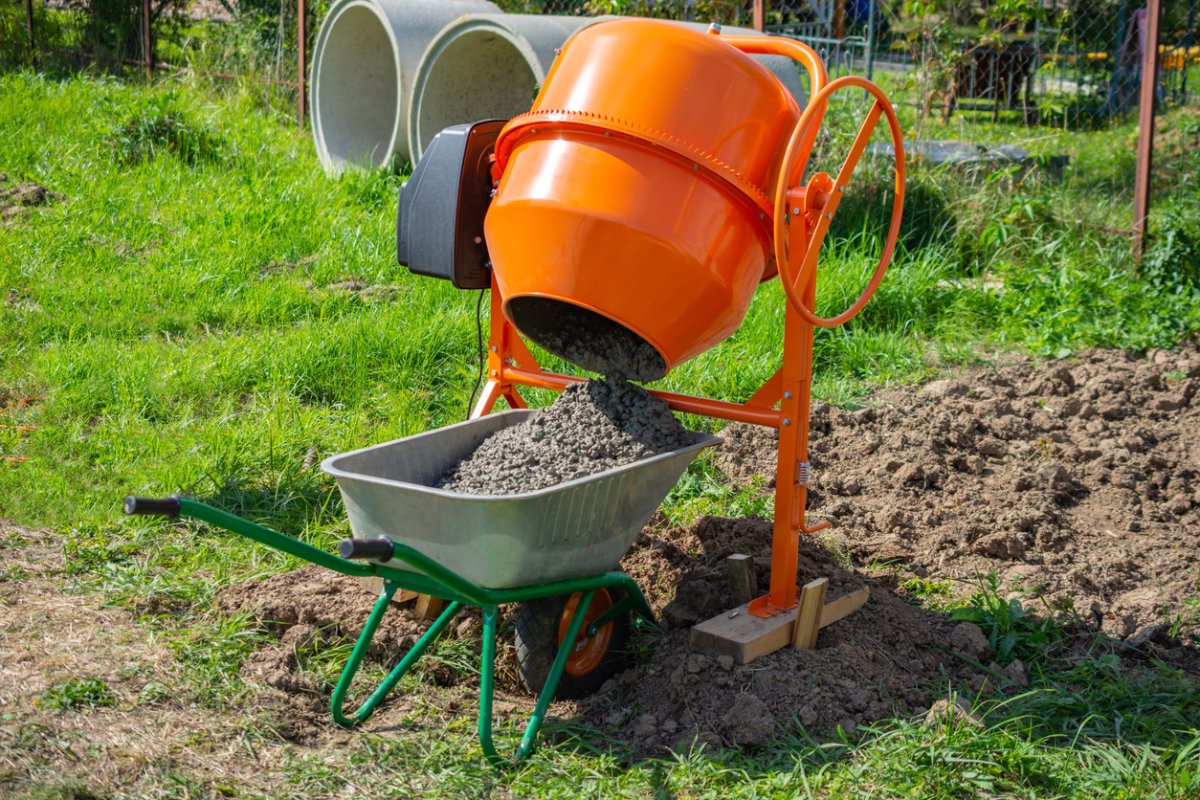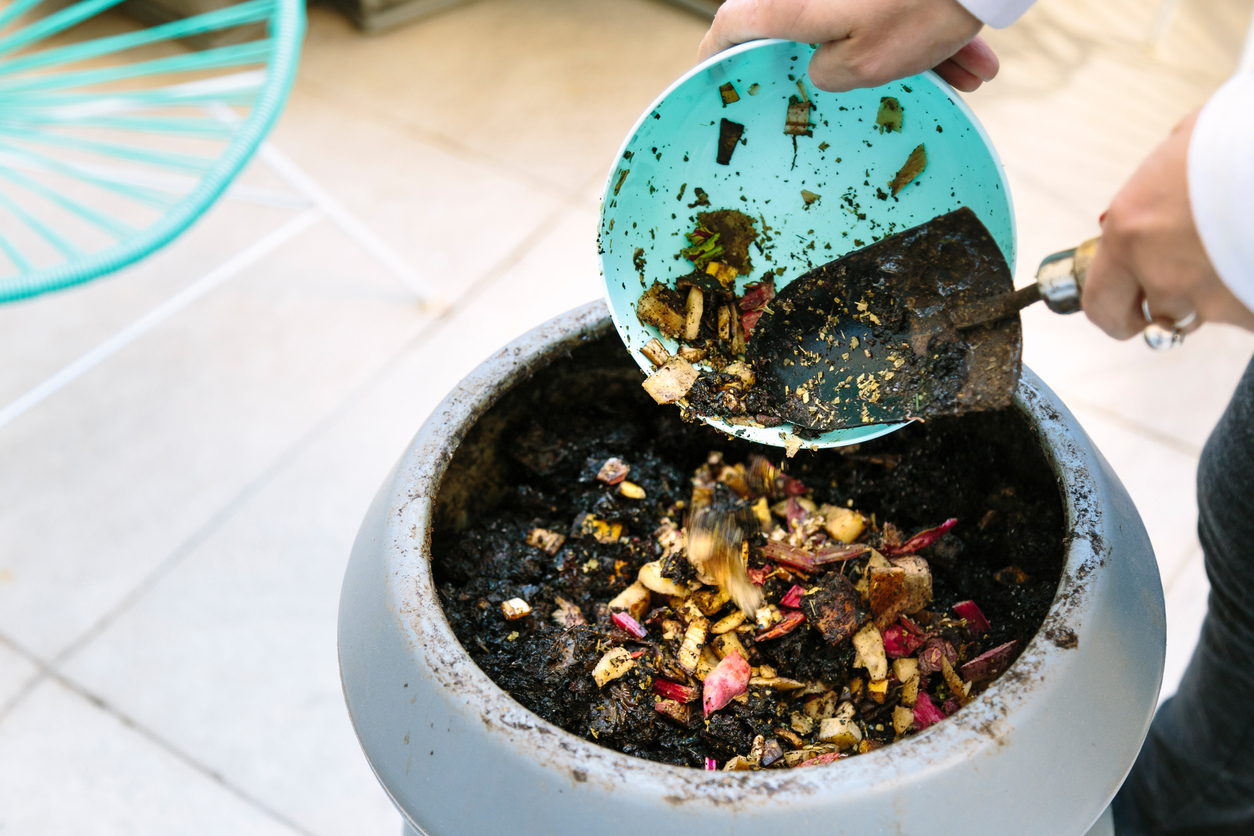

We may earn revenue from the products available on this page and participate in affiliate programs. Learn More ›
Have you ever seen a concrete mixer in someone’s yard and wondered, “Why would anyone actually own one of those?” Or, maybe you bought one for a project ages ago, thinking it could come in handy in the future, only to see it now sit dormant in the back of the shed. Look at your concrete mixer from another perspective and that seeming single-tasker could prove much more versatile than you think.
A concrete mixer can make a surprising assortment of jobs easier. Ahead, we’ve identified some of the most ingenious tasks that concrete mixers can tackle in addition to stirring up concrete mix. If using a rented mixer, just ensure you clean the mixer carefully before returning it and do not damage the equipment.
1. Make a custom-blend homemade potting soil.

Gardeners and farmers have discovered several alternative uses for a concrete mixer for blending heavy materials together. Potting soil is made of various bulk organic ingredients that should be worked into a consistent mix. The turning action of the concrete mixer’s drum makes it perfect for blending homemade potting soil. It keeps the material moving steadily, and the built-in paddles break up clumps.
Of course, the actual mix recipe depends on the intended plants or purpose. Regardless, if you plan to fill several containers or a raised bed, you can save money and ensure quality by mixing your own soil in a concrete mixer. A good general-purpose potting mix includes 6 parts peat moss (plus 1 tablespoon of garden lime per gallon of peat moss) or coir fiber, 6 parts screened aged compost, 4.5 parts perlite, and 0.5 part organic balanced organic fertilizer (5-5-5, or similar). Turn on the machine, load the ingredients, and let it mix for about 5 minutes.
RELATED: The Dos and Don’ts of DIY Potting Soil
2. Mix mortar for working with bricks, blocks, and stone.

While it is similar to concrete, mortar differs in terms of ingredients, texture, and application. Mortar is the adhesive used to hold masonry materials like bricks, concrete blocks, and stones together, it’s made of 1 part cement, 3 parts sand, and 1 part water.
Although a mortar mixer is specifically designed for the task, with mixing paddles that rotate inside a stationary drum instead of the concrete mixer’s fixed paddles inside the rotating drum, a concrete mixer can do a fine job with mortar. Turn on the mixer, then add water, cement, and sand. Let it run for 5 to 10 minutes, until the mortar has the consistency of peanut butter.
RELATED: Solved! The Purpose of Weep Holes in Brick
3. DIY a custom-blend fertilizer.

Farmers and gardeners rely on soil test results to guide their fertilizer applications. Unfortunately, premixed fertilizers only come in a few ranges of nitrogen (N), phosphorus (P), and potassium (K) ratios that might not align with recommendations based on soil testing. The good news is that you can purchase fertilizer ingredients such as blood meal, bone meal, and potash, and use a concrete mixer to blend homemade fertilizer at the recommended ratio for your yard or garden.
This project might produce dust, so you will want to fashion a fabric or wooden cover for the drum and wear a dust mask. Add the dry ingredients to the drum, then cover the top and mix for 5 minutes.
RELATED: 15 Secret Ingredients to Make Your Garden Grow
4. Build a DIY compost tumbler.

The worst part about making compost is turning the pile. This exhausting and time consuming process, once done by pitchfork, was simplified with the invention of hand-crank compost tumblers. You can take it a step further by converting an old concrete mixer into an electric DIY compost tumbler by either replacing the drum with a perforated one, or by drilling drainage holes into the base of the existing drum (if you do this, it will no longer be suitable for mixing concrete). A large capacity mixer of 6 cubic feet or more, will give best results.
After modifying the drum, load it with kitchen scraps, garden debris, shredded paper, and other compostable material, dampen the mix, and rotate the drum a few turns daily. You could even set it on an electrical timer to automatically turn a few times at the same time each day. Under ideal conditions, it will process a batch in 4 to 6 weeks.
RELATED: How to Build a DIY Pallet Compost Bin
5. Make a metal tumbler to remove rust and scale.

The rotation of a concrete mixer is also ideal for tumbling metal parts to remove rust. The process is extra loud, so be sure to set up where loud noise is acceptable. It might be a good idea to wrap the exterior of the drum in heavy-duty felt or foam to dampen the sound.
Load the drum with the parts to be cleaned, along with small metal scraps such as nails, steel punch drops, nails, screws, welding rod ends, etc. Alternatively, seal these materials inside a metal container that can be wrapped in noise-dampening material and placed inside the mixer drum. Turn on the mixer to agitate the rust away, checking after several hours; some items will take longer than others.
RELATED: The Best Rust Removers
6. Make sea glass for crafting.

Sea glass is the result of broken bits of bottles, dishes, and other glassware that has tumbled among the sand and waves for many years. Beachcombers love collecting the smooth, colorful souvenirs, and crafters turn sea glass into jewelry or home decor. If you love the look but cannot get to the beach, you can use a concrete mixer to replicate the ocean waves and make faux sea glass.
Break colorful glass into pieces of various sizes, but not too small since tumbling will make them smaller. Carefully add a generous amount of broken glass to the mixer drum , cover the glass with water, and toss in a few cups of quartz sand or silicon carbide tumbling grit. Run the mixer for a few days or a week, the longer the better. The glass will come out smooth with a matte finish, just like at the beach.
RELATED: How to DIY a Mosaic with Broken Tiles
7. Build a rotary compost sifter.

Sifted compost is one of the best ingredients for seed starting and potting soils. Most gardeners sift their compost to remove large pieces of debris by placing it on wire mesh mounted on a frame, and shaking it back and forth over a wheelbarrow. It works, but it’s a laborious and time-consuming process. If you have a concrete mixer, you can speed things along with just a few modifications.
Use an old washing machine drum, a steel mesh trash can to make a trommel, or rotary sifter attachment for your concrete mixer. Depending on the mixer you’re working with, you can mount the trommel over the mouth of the existing drum, or remove the concrete drum to mount the trommel on the mixer’s ring gear.
Once the new hardware is installed, place a tarp or wheelbarrow below the trommel to catch sifted compost, turn on the machine and load it a shovel load at a time. Return the coarse material to the compost bin for further processing. The same setup works great for sifting rocks from soil for garden bed prep.
RELATED: Is a Lomi Composter the Easiest Way to Turn Food Scraps Into Soil? We Tested It to Find Out
8. Mix custom feed blends for livestock.

Mixing your own custom animal feed can be a money saver and can be better for the animals too. Blending livestock feed by hand is not uncommon, and may work fine when you have just a few small animals. As the flock grows, powering the process with the help of a concrete mixer allows you to spend more time with the animals and less time on feeding logistics.
Good blending ensures a precise ratio of ingredients in each scoop of the final mix. Add grains and seeds such as corn, flaxseed, oats, peas, sunflower kernels, and wheat in the desired ratio to the mixer, turn it on, and let it mix for 5 minutes or so. You’ll get bigger batches that are blended faster and more evenly than when mixing by hand.
RELATED: 11 Things You Need If You’re Raising Backyard Chickens
9. Mix hypertufa for handmade garden planters.

Hypertufa is a lightweight casting medium made of cement, fine aggregate, and organic matter. Gardeners use it to create custom planters that offer an ideal growing environment for alpine plants, succulents, and annuals. Once cured, the material withstands freezing temperatures, and gives the look of concrete or natural stone at a fraction of the weight and cost. It even takes on a mossy patina in just a season or two.
To mix a batch of hypertufa, one part of Portland cement with 1½ parts perlite or sand and 1½ parts peat moss. Add some water to the concrete mixer first, then add hypertufa mix. There is no strict water-to-hypertufa mix ratio because perlite, sand, and peat moss hold varying amounts of moisture. The final mix should appear somewhat like dry cooked oatmeal. If you can squeeze a ball together and it sticks without wringing out much water, it’s about right. Let it rest for 5 minutes or so and then use it to fill forms. You can also purchase one of these planters to try before you spend time crafting; the round hypertufa planter by DeJardinCreations is available at Etsy.
RELATED: 17 Planter Box Plans You Can DIY This Weekend
10. Mix concrete for countertops, fence posts, and other midsize projects.

Of course the primary job for a concrete mixer is to blend water with dry concrete mix. But you don’t have to pull it out only for large projects. The mixer is a great option for quick repairs or projects that call for more concrete than a bucket or wheelbarrow can hold. When completing small- to medium-size projects—especially those that require a consistent mix for strength or appearance—you can’t beat the use of a mixer instead of hand-stirring or using a drill with a mixer attachment.
The process is simple: turn on the machine, add water (about 3 quarts per 80-pound bag of mix), add dry mix, let it stir and tumble for 3 to 5 minutes, and pour. For multiple runs or multiple-day projects, some users buy bulk ingredients to make their own concrete dry mix. A good general-purpose dry mix includes 1 part cement, 2 parts sand, 4 parts gravel, and 1.5 to 2 parts water.
RELATED: How To: Make Concrete Garden Edging
